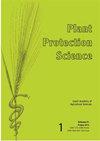新型化学杀虫剂对地下白蚁的防治效果评价
IF 1.7
4区 农林科学
Q2 AGRONOMY
引用次数: 0
摘要
白蚁攻击可使作物和森林生产力显著降低10%至25%,而巴基斯坦通常使用传统化学杀虫剂。然而,本研究旨在评估10种不同杀虫剂在不同浓度和时间间隔下对地下白蚁的控制效果。氟虫腈和毒死蜱在浓度为125 ppm时是最有效的杀虫剂,在接触24小时后死亡率为100%,而苯甲酸酯的死亡率最低,但随着时间的推移逐渐增加。在250 ppm浓度下测试的所有杀虫剂都造成不同程度的死亡率,吡虫啉、氟虫腈和联苯菊酯是最有效的。在浓度为500ppm时,所有杀虫剂都有效,吡虫啉显示出最快的死亡率。同样,所有浓度为1000 ppm的杀虫剂都有效,氟虫腈是最有效的杀虫剂。结果表明,某些杀虫剂对地下白蚁的防治效果优于其他杀虫剂,且杀虫剂的使用时间对其防治效果也有重要影响。研究发现,高剂量的新型化学杀白剂在最短的暴露时间后导致地下白蚁死亡率最高。在特定剂量和暴露时间下,氟虫腈、吡虫啉和联苯菊酯是达到100%白蚁死亡率的最有效的处理方法,而氯虫腈和苯甲酸埃马菌素的效果较低。新的化学杀虫剂被认为是生态友好的,对人类和非目标动物是安全的,可能是害虫综合治理计划的一个有效选择本文章由计算机程序翻译,如有差异,请以英文原文为准。
Assessing the Efficacy of New Chemistry Insecticides against Subterranean Termite
Termite attacks can significantly reduce crop and forest productivity by 10 to 25 percent, with traditional chemical insecticides commonly used in Pakistan. The present study, however, aimed to assess the effectiveness of ten different insecticides in controlling subterranean termites at various concentrations and time intervals. Fipronil and Chlorpyrifos were the most effective insecticides at a concentration of 125 ppm, resulting in 100% mortality rates after 24 hours of exposure, while Emamectin Benzoate had the lowest mortality rates, but gradually increased over time. All insecticides tested at a concentration of 250 ppm resulted in varying degrees of mortality rates, with Imidacloprid, Fipronil, and Bifenthrin being the most effective. At a concentration of 500 ppm, all insecticides were effective, with Imidacloprid showing the fastest onset of mortality. Similarly, all insecticides at a concentration of 1000 ppm were effective, with Fipronil being the most effective insecticide. The data suggested that some insecticides were more effective than others in controlling subterranean termites, and the duration of exposure also played a crucial role in the effectiveness of the insecticides. The study found that higher dosages of new chemistry-based termiticides result in maximum subterranean termite mortality after a minimum exposure time. Fipronil, Imidacloprid, and Bifenthrin were the most effective treatments achieving 100% termite mortality at specific dosages and exposure times, while Chlorfenapyr and Emamectin Benzoate showed lower effectiveness. The new chemistry insecticides are considered eco-friendly, safe for humans and non-target fauna, and might be a competent choice for integrated pest management programs
求助全文
通过发布文献求助,成功后即可免费获取论文全文。
去求助
来源期刊

Plant protection science
Agronomy-PLANT SCIENCES
CiteScore
2.90
自引率
7.70%
发文量
30
审稿时长
12 weeks
期刊介绍:
Original papers, short communications, critical reviews, personal news, and book reviews covering all areas of diseases and pests of plants, weeds and plant protection. Papers are published in English.
 求助内容:
求助内容: 应助结果提醒方式:
应助结果提醒方式:


